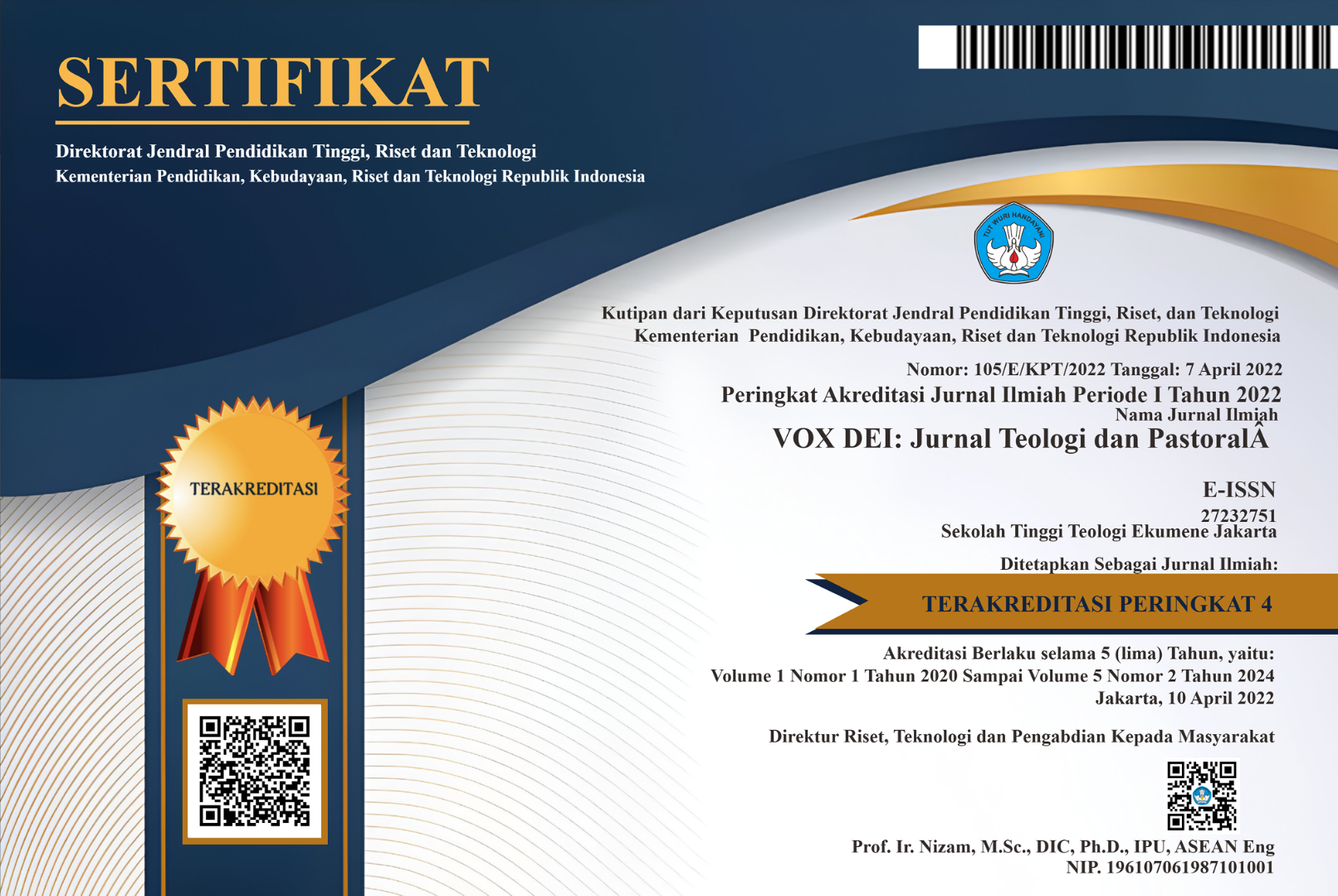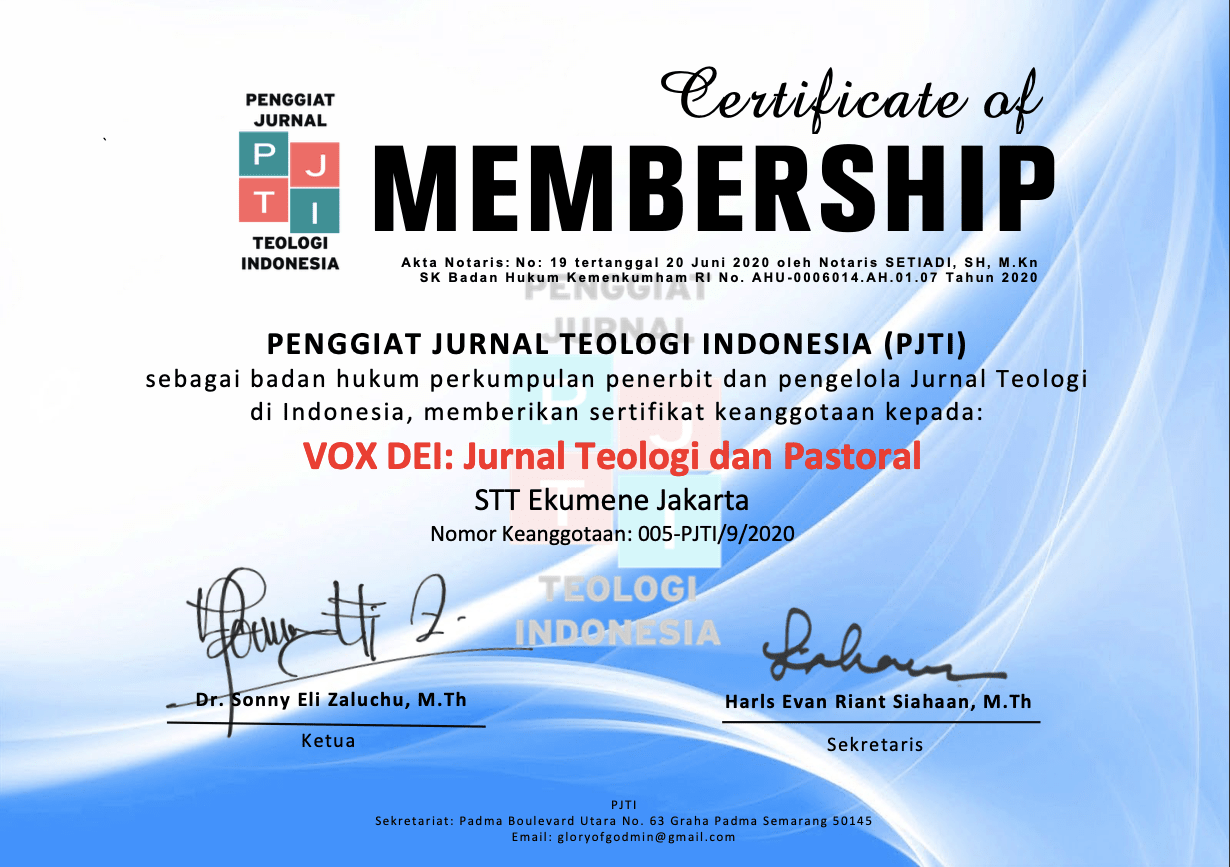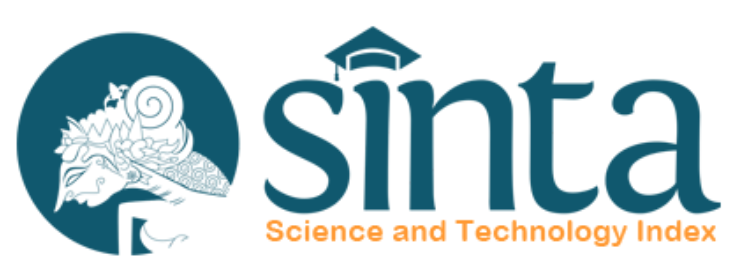Goliat Sang Pahlawan Filistin: Re-Reading 1 Samuel 17 Dalam Perspektif Pascakolonial
DOI:
https://doi.org/10.46408/vxd.v5i1.482Keywords:
David; Goliath; big man; masculinity; postcolonialismAbstract
The fight between David and Goliath is a metaphor used to describe the unequal confrontation between a small power and a large power. This fight shows David's courage and resilience amidst physical injustice and an imbalance of power. As a result, Goliath is depicted as a strong figure because he has a large body, while David is the opposite. This stereotype influences the perception of men with large bodies. This research seeks to discuss the stigma of masculinity experienced by men who have large bodies. Masculinity, even hypermasculinity, is sometimes a stigma attached to the self-image of large men who convey an aggressive and oppressive impression. For men with large bodies, the result of patriarchal standards becomes gender violence which also paralyzes men. Departing from postcolonial criticism which emphasizes the relationship between domination and subordination, this article examines and re-question the reader's position in seeing the character Goliath affected by the stigma of masculinity in his battle with David. Through text analysis methods, the author tries to reconstruct the reading of 1 Samuel 17 by describing the battle of Goliath, the champion of the Philistines, with David who represented the Israelites. This article finds that Goliath's large body was not his strength, but rather a source of weakness. In this way, this article breaks down the stigma of hypermasculinity attached to large men. Awareness of violence that does not look at gender, presents an inclusive reading full of new meaning for Goliath, the reader and the current context.
Downloads
References
Auld, A. G. (2011). I & II Samuel: A commentary (1st ed). Westminster John Knox Press.
Beck, J. A. (2006). David And Goliath, A Story Of Place: The Narrative-Geographical Shaping Of 1 Samuel 17. Westminster Theological Journal, 68(2).
Bodner, K. (2008). 1 Samuel: A narrative commentary. Sheffield Phoenix Press.
Buntu, I. S. (2018). Membaca Teks dalam Pandangan Poskolonial: Catatan Kritis atas Bacaan Terhadap Teks Kitab Suci. BIA’: Jurnal Teologi dan Pendidikan Kristen Kontekstual, 1(2), Article 2. https://doi.org/10.34307/b.v1i2.46
Esler, P. F. (2012). Sex, wives, and warriors: Reading Old Testament narrative with its ancient audience. James Clarke.
Friedmann, J. L. (2022). Goliath as gentle giant: Sympathetic portrayals in popular culture. Lexington Books, an imprint of The Rowman & Littlefield Publishing Group, Inc.
Gladwell, M. (2013). David and Goliath: Underdogs, misfits, and the art of battling giants (First edition). Little, Brown and Company.
Halberṭal, M., & Holmes, S. (2019). The beginning of politics: Power in the biblical Book of Samuel. Princeton University Press.
Hasil Pencarian—KBBI Daring. (n.d.). Retrieved June 14, 2023, from https://kbbi.kemdikbud.go.id/entri/stereotipe
Killebrew, A. E. (2005). Biblical peoples and ethnicity: An archaeological study of Egyptians, Canaanites, Philistines, and early Israel, 1300-1100 B.C.E. Society of Biblical Literature.
La Sor, W. S., Hubbard, D. A., Bush, F. W., & Allen, L. C. (1996). Old Testament survey: The message, form, and background of the Old Testament (2nd ed). W.B. Eerdmans.
Mamahit, F. Y. (2021). Postcolonial Reading of the Bible: (Evangelical) Friend or Foe? Jurnal Jaffray, 19(2), 129. https://doi.org/10.25278/jj.v19i2.563
McKenzie, S. L., & Kaltner, J. (Eds.). (2013). New meanings for ancient texts: Recent approaches to biblical criticisms and their applications (First edition). Westminster John Knox Press.
Moore, S. D., & Segovia, F. F. (Eds.). (2007). Postcolonial biblical criticism: Interdisciplinary intersections. T & T Clark International.
Setio, R., Wibowo, W. S., & Widjaja, P. S. (Eds.). (2019). Teks dan konteks berteologi lintas budaya (Cetakan ke-1). BPK Gunung Mulia.
Singgih, E. G. (2009). Menguak isolasi, menjalin relasi: Teologi Kristen dan tantangan dunia postmodern (Cet. 1). BPK Gunung Mulia.
Smit, P.-B. (2017). Masculinity and the Bible: Survey, models, and perspectives. Brill.
Sugirtharajah, R. S. (2001). The Bible and the Third World: Precolonial, colonial, and postcolonial encounters. Cambridge University Press.
Sugirtharajah, R. S. (Ed.). (2006). The postcolonial Biblical reader. Blackwell Pub.
Sun, C. (2019). Recent Research on Asian and Asian American Hermeneutics Related to the Hebrew Bible. Currents in Biblical Research, 17(3), 238–265. https://doi.org/10.1177/1476993X19832139
Wibowo, W. S., & Setio, R. (Eds.). (2016). Teologi yang membebaskan dan membebaskan teologi. Yayasan Taman Pustaka Kristen Indonesia: Fakultas Teologi, Universitas Kristen Duta Wacana.
















